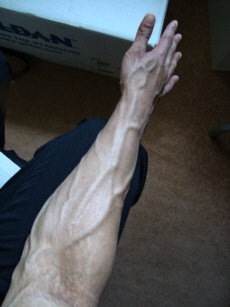 W
WThe circulatory system, also called the cardiovascular system or the vascular system, is an organ system that permits blood to circulate and transport nutrients, oxygen, carbon dioxide, hormones, and blood cells to and from the cells in the body to provide nourishment and help in fighting diseases, stabilize temperature and pH, and maintain homeostasis.
 W
WArterial calcification due to deficiency of CD73 (ACDC) is a rare genetic disorder that causes calcium buildup in the arteries and joints of the hands and feet, and other areas below the waist. Although patients exhibiting these symptoms have been identified as early as 1914, this disorder had not been studied extensively until recently. The identification of the specific ACDC gene and mutations occurred in 2011. ACDC is caused by a mutation in the NT5E gene, which prevents calcium-removing agents from functioning,. Patients afflicted with this mutation suffer from chronic pain, difficulty moving, and increased risk of cardiovascular problems. In experiments at the molecular level, treatment with adenosine or a phosphatase inhibitor reversed and prevented calcification, suggesting they could be used as possible treatment methods. There is currently no cure for ACDC, and patients have limited treatment options which focus primarily on removal of blood calcium and improving mobility.
 W
WThe basilic vein is a large superficial vein of the upper limb that helps drain parts of the hand and forearm. It originates on the medial (ulnar) side of the dorsal venous network of the hand and travels up the base of the forearm, where its course is generally visible through the skin as it travels in the subcutaneous fat and fascia lying superficial to the muscles.
 W
WThe blood–brain barrier (BBB) is a highly selective semipermeable border of endothelial cells that prevents solutes in the circulating blood from non-selectively crossing into the extracellular fluid of the central nervous system where neurons reside. The blood–brain barrier is formed by endothelial cells of the capillary wall, astrocyte end-feet ensheathing the capillary, and pericytes embedded in the capillary basement membrane. This system allows the passage of some molecules by passive diffusion, as well as the selective and active transport of various nutrients, ions, organic anions, and macromolecules such as glucose, water and amino acids that are crucial to neural function.
 W
WIn human anatomy, the cephalic vein is a superficial vein in the arm.
 W
WAs in other molluscs, the circulatory system of gastropods is open, with the fluid, or haemolymph, flowing through sinuses and bathing the tissues directly. The haemolymph typically contains haemocyanin, and is blue in colour.
 W
WThe microcirculation is the circulation of the blood in the smallest blood vessels, the microvessels of the microvasculature present within organ tissues. The microvessels include terminal arterioles, metarterioles, capillaries, and venules. Arterioles carry oxygenated blood to the capillaries, and blood flows out of the capillaries through venules into veins.
 W
WPrecapillary resistance is the modulation of blood flow by capillaries through vasomotion, either opening (dilating) and letting blood pass through, or by constricting their lumens, reducing bloodflow through the capillary bed. It is not entirely clear how precapillary resistance is created in many parts of the body. Precapillary sphincters are smooth muscle structures that mediate the precapillary resistance in the mesenteric microcirculation.
 W
WA precapillary sphincter is a band of contractile mural cells either classified as smooth muscle or pericytes that adjusts blood flow into capillaries. They were originally described in the mesenteric microcirculation, and were thought to only reside there. At the point where each of the capillaries originates from an arteriole, contractile mural cells encircle the capillary. This is called the precapillary sphincter. The precapillary sphincter has now also been found in the brain, where it regulates blood flow to the capillary bed. The sphincter can open and close the entrance to the capillary, by which contraction causes blood flow in a capillary to change as vasomotion occurs. In some tissues, the entire capillary bed may be bypassed by blood flow through arteriovenous anastomoses or through preferential flow through metarterioles. If the sphincter is damaged or cannot contract, blood can flow into the capillary bed at high pressures. When capillary pressures are high, fluid passes out of the capillaries into the interstitial space, and edema or fluid swelling is the result.
 W
WA rete mirabile is a complex of arteries and veins lying very close to each other, found in some vertebrates, mainly warm-blooded ones. The rete mirabile utilizes countercurrent blood flow within the net to act as a countercurrent exchanger. It exchanges heat, ions, or gases between vessel walls so that the two bloodstreams within the rete maintain a gradient with respect to temperature, or concentration of gases or solutes. This term was coined by Galen.
 W
WVascularity, in bodybuilding, is the condition of having many highly-visible, prominent, and often extensively-ramified superficial veins. The skin appears "thin" — sometimes virtually transparent — due to an extreme reduction of subcutaneous fat, allowing for maximum muscle definition.